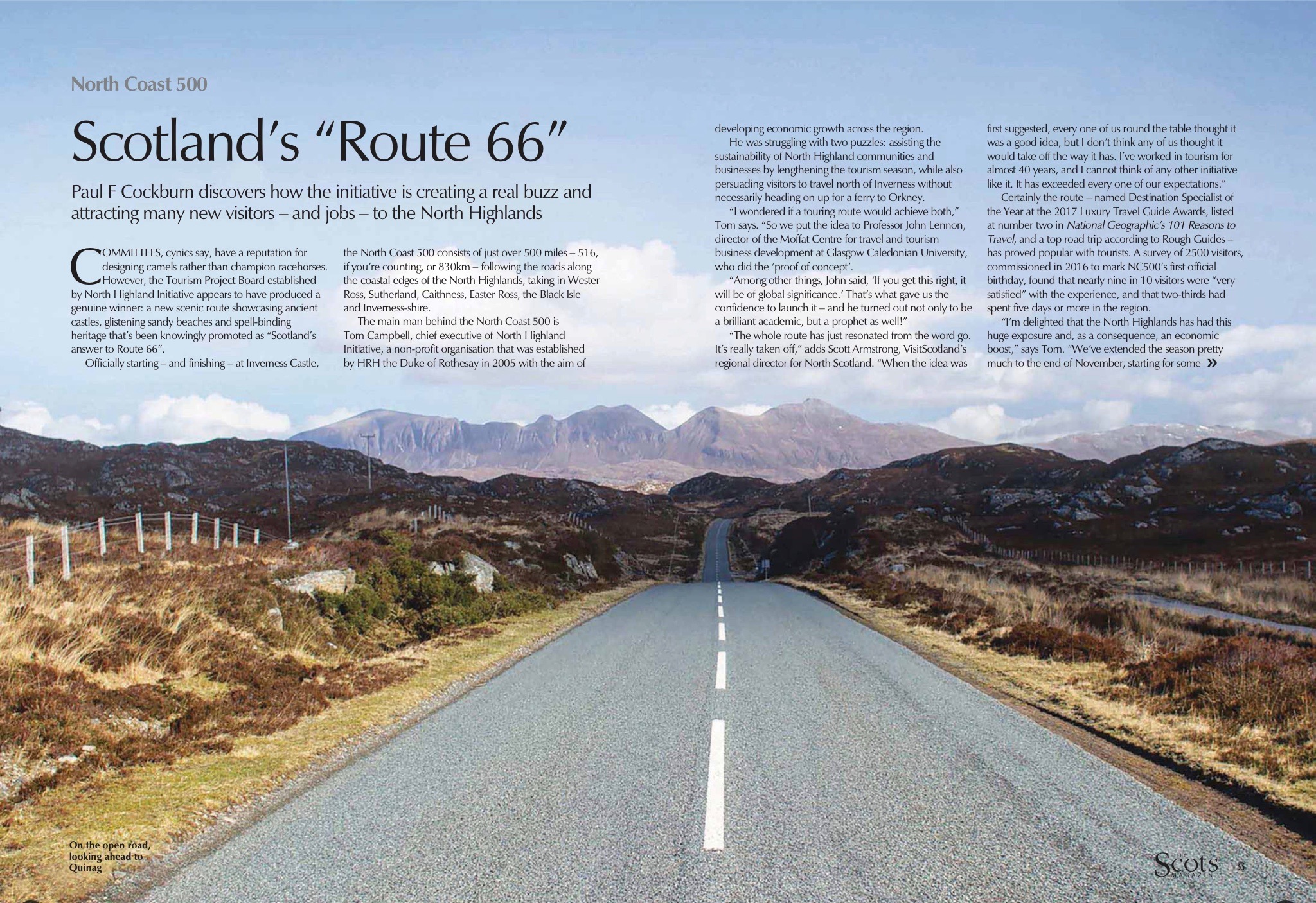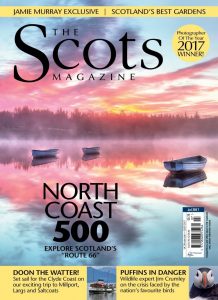
Committees, cynics say, have a reputation for designing camels rather than champion racehorses. However, the Tourism Project Board established by North Highland Initiative appears to have produced a genuine winner: a new scenic route showcasing ancient castles, glistening sandy beaches and spell-binding heritage that’s been knowingly promoted as “Scotland’s answer to Route 66”.
Officially starting—and finishing—at Inverness Castle, the North Coast 500 (aka “NC500”) consists of just over 500 miles—516, if you’re counting—following the roads along the coastal edges of the North Highlands, taking in Wester Ross, Sutherland, Caithness, Easter Ross, the Black Isle and Inverness-Shire.
 The principal man behind the North Coast 500 is Tom Campbell, Chief Executive of North Highland Initiative, a non-profit organisation established by HRH Prince Charles in 2005 to develop economic growth across the region. He was struggling with two puzzles: assisting the sustainability of North Highland communities and businesses by lengthening the tourism season, while also persuading visitors to travel north of Inverness without necessarily heading on up for a ferry to Orkney.
The principal man behind the North Coast 500 is Tom Campbell, Chief Executive of North Highland Initiative, a non-profit organisation established by HRH Prince Charles in 2005 to develop economic growth across the region. He was struggling with two puzzles: assisting the sustainability of North Highland communities and businesses by lengthening the tourism season, while also persuading visitors to travel north of Inverness without necessarily heading on up for a ferry to Orkney.
“I wondered if a touring route would achieve both,” Tom says. “So we put the idea to Professor John Lennon, Director of the Moffat Centre for Travel and Tourism Business Development at Glasgow Caledonian University, who did the ‘proof of concept’. Amongst other things, John said: ‘If you get this right, it will be of global significance.’ That’s what gave us the confidence to launch it—and he turned out not only to be a brilliant academic, but a prophet as well!”
“The whole route has just resonated from the word go; it’s really taken off,” adds Scott Armstrong, Visit Scotland’s regional director for North Scotland. “When the idea was first suggested, every one of us round the table thought it was a good idea, but I don’t think any of us thought it would take off the way it has. I’ve worked in tourism for almost 40 years, and I cannot think of any other initiative like it. It has exceeded every one of our expectations.”
Certainly the route—Destination Specialist of the Year at the 2017 Luxury Travel Guide Awards, Number 2 in National Geographic’s “101 Reasons to Travel”, and a top road trip according to Rough Guides—has proved popular with tourists. A survey of some 2,500 visitors, commissioned in 2016 to mark NC500’s first official birthday, found that nearly nine in ten visitors were “very satisfied” with the experience, and that two thirds had spent five days or more in the region.
“I’m delighted that the North Highlands has had this huge exposure and, as a consequence, an economic boost,” says Tom. “We’ve extended the season pretty much to the end of November, starting for some businesses in February. Occupancy levels are like we’ve never seen before. Actually, one of the key things people say is that the journey for them has been life-changing, which is not something we had anticipated—although a lot of our emphasis was around the experience and being part of a club in that you’ve ‘done the North Coast 500’.”
“In our opinion, the North Coast 500 has been a huge success and we have seen a noticeable increase in visitor numbers since it launched,” adds Scott Morrison, Managing Director at Dunrobin Castle in Golspie. “The North Coast 500 has brought excitement and buzz to the Highlands which we haven’t seen before. We are now talking to visitors who are doing the route almost on a daily basis.”
It’s been estimated that general increases in trade experienced by many hospitality-related businesses could already have lead to the creation of around 200 new jobs in what remains one of the remotest parts of Scotland.
“Tourism is one of our region’s principal growth sectors,” says David Oxley of Highland and Islands Enterprise. “It creates jobs in remote rural locations, particularly jobs for young people, and helps promote the Highlands and Islands across the world. NC500 is a great example of a creative tourism initiative. It promotes some of the best scenery the north of Scotland has to offer and its huge consumer reach presents a massive opportunity for many businesses.”
This is all the more significant since, as Scott Armstrong admits, in the past it has previously been challenging to persuade visitors to travel north of Inverness. “They’ll go across to Skye—Skye is a really popular destination—and obviously to Loch Ness, but to go further north was always much more of a challenge,” he says. “Suddenly people are coming into our Inverness Information Centre saying: ‘We’re here to do the North Coast 500.’ They’re wanting to go to the North Highlands because of the North Coast 500.”
Success has not come without its challenges, however: the North Coast 500 is a virtual route placed over existing roads. Earlier this year, residents in the Sutherland village of Elphin argued for the introduction of new speed limits and other traffic-calming measures to lessen perceived dangers from an estimated trebling of traffic since the launch of NC500.
Tom Campbell recognises these need to be addressed, if only for the long-term future of the region. “This gives the North Highlands probably one of the best opportunities we’ve ever had to argue for infrastructure investment,” he says, “on the basis that ‘Why would you kill the goose that’s laying the golden eggs?’ But for me, infrastructure is much broader and deeper than just filling pot-holes. Yes, it’s about roads, the passing places with toilets, the harbours, the coastline. But it’s also about accommodation, it’s about what people can do, it’s about up-skilling the workforce.”
The success of North Coast 500 has not gone unnoticed either, according to Scott Armstrong. “Right at this moment, other parts of Scotland are thinking: ‘Can we develop something similar here?’ Whether or not they’re able to emulate the success of the North Coast 500, there’s a big question mark there. But it won’t do any harm to try.”
Useful tips to get the best out of NC500:
• Do your homework: www.northcoast500.com has lots of information on attractions and suggested itineraries.
• Book your accommodation as early as possible; it can get really busy during the summer.
• Read up on road etiquette; there’s lots of useful advice on the NC500 website. Parts of NC500 are along single-track roads, which can be “a bit tricky” to navigate.
• If you have a smartphone, you can download a free North Coast 500 App which includes an interactive map, example itineraries, and other online services.
• Become a NC500 member and receive an array of benefits, including access to a members only area of the website: basic membership starts at £15 a year.
First published in The Scots Magazine, #July 2017.